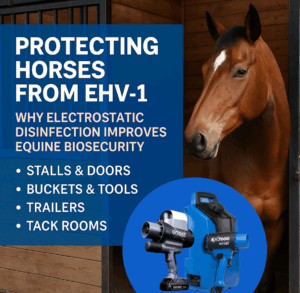Protecting Horses From EHV-1: Why Electrostatic Disinfection Improves Equine Biosecurity
EHV-1 prevention is one of the most pressing concerns for horse owners, trainers, boarding facilities, and equine veterinarians. Because the EHV-1 virus in horses can spread rapidly through direct contact and contaminated surfaces, barns need a stronger approach to surface sanitation.
EMist® electrostatic sprayers help equine facilities improve horse barn sanitation, reduce viral transmission, and strengthen overall equine biosecurity.
What Makes EHV-1 So Dangerous?
The EHV-1 virus spreads through:
-
Horse-to-horse contact
-
Contaminated equipment, stalls, and tools
-
Human hands, boots, and clothing
-
Airborne particles in enclosed barns
EHV-1 can survive on surfaces for hours to days, allowing the virus to spread through shared spaces even after traditional cleaning.
This makes regular barn disinfection an essential part of preventing outbreaks.
https://equinediseasecc.org/news/article/Equine-Herpesvirus-Myeloencephalopathy-(EHM)-Outbreak
Why Electrostatic Disinfection Works Better for EHV-1 Prevention
Traditional spray-and-wipe methods often leave untreated surfaces behind. Stalls, tack rooms, cross-ties, and grooming areas have crevices that are hard to reach manually.
EMist® electrostatic sprayers solve this problem with:
-
360° coverage that wraps disinfectant around all surfaces
-
Patented induction-charging technology for consistent application
-
Up to 75% less chemical usage compared to manual spraying
-
Fast, efficient coverage for high-traffic equine environments
-
Proven performance in veterinary and high-risk facilities
For facilities looking to prevent EHV-1, electrostatic application ensures every surface—including hidden and porous areas—is fully treated.
High-Risk Areas That Must Be Disinfected in Every Barn
To effectively prevent EHV-1 in horses, equine facilities should regularly disinfect:
-
Stall doors, walls, and latches
-
Feed and water buckets
-
Cross-tie posts & grooming equipment
-
Tack rooms
-
Aisles and common areas
-
Horse trailers and transport equipment
-
Veterinary exam rooms
-
Wash racks and grooming stations
Each of these areas is a common source of contamination during EHV-1 activity.
Building a Stronger Equine Biosecurity Plan
An effective equine biosecurity program should include:
- Consistent disinfection using electrostatic sprayers
- Isolation of new or symptomatic horses
- Hand hygiene and boot scrubbing protocols
- Separate equipment for each horse when possible
- Daily disinfection of high-touch surfaces
- Clear communication during outbreaks
By pairing these steps with EMist technology, barns create safer environments and reduce downtime from outbreaks.
Why Equine Facilities Trust EMist for EHV-1 Prevention
EMist brings hospital-grade, science-backed disinfection to the equine industry. Our sprayers help:
-
Protect horses from EHV-1
-
Reduce labor and cleaning time
-
Cut chemical waste
-
Improve coverage in hard-to-reach areas
-
Strengthen overall barn sanitation
Whether you manage a small boarding barn or a large training operation, EMist makes it easier to stay proactive instead of reactive.
Ready to Strengthen Your EHV-1 Prevention Plan?
EMist helps equine facilities protect horses and maintain cleaner, safer environments with advanced electrostatic technology.
Contact us for product recommendations, quotes, or a demo tailored to your barn’s needs.
